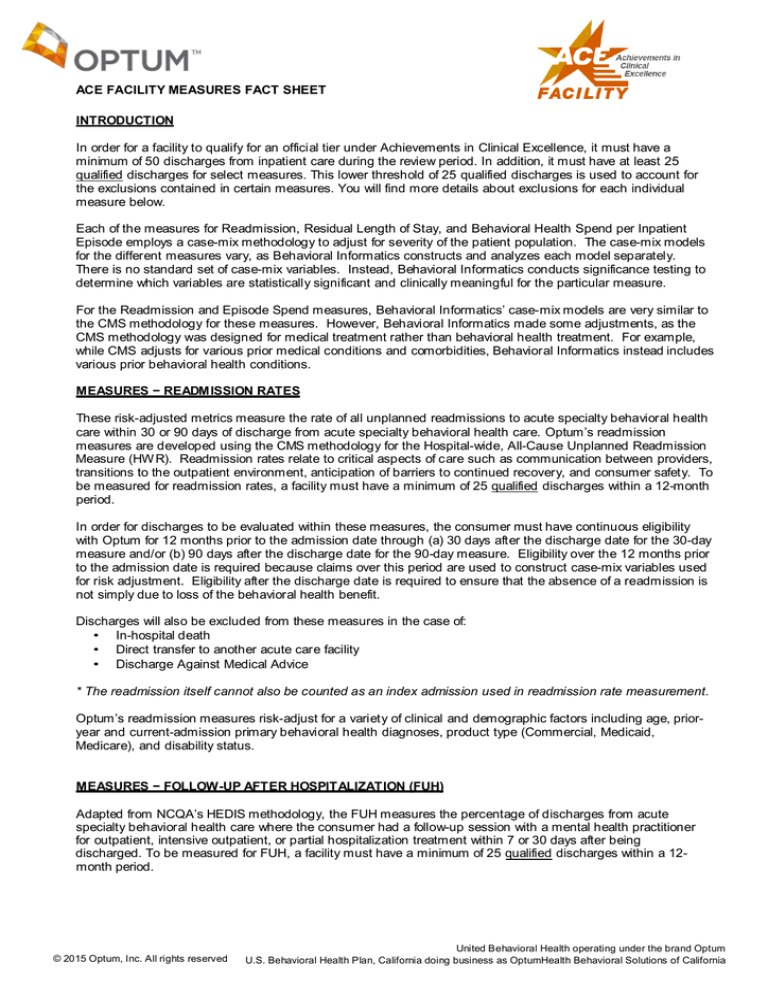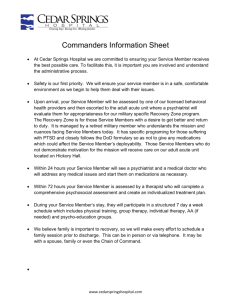
ACE FACILITY MEASURES FACT SHEET
INTRODUCTION
In order for a facility to qualify for an official tier under Achievements in Clinical Excellence, it must have a
minimum of 50 discharges from inpatient care during the review period. In addition, it must have at least 25
qualified discharges for select measures. This lower threshold of 25 qualified discharges is used to account for
the exclusions contained in certain measures. You will find more details about exclusions for each individual
measure below.
Each of the measures for Readmission, Residual Length of Stay, and Behavioral Health Spend per Inpatient
Episode employs a case-mix methodology to adjust for severity of the patient population. The case-mix models
for the different measures vary, as Behavioral Informatics constructs and analyzes each model separately.
There is no standard set of case-mix variables. Instead, Behavioral Informatics conducts significance testing to
determine which variables are statistically significant and clinically meaningful for the particular measure.
For the Readmission and Episode Spend measures, Behavioral Informatics’ case-mix models are very similar to
the CMS methodology for these measures. However, Behavioral Informatics made some adjustments, as the
CMS methodology was designed for medical treatment rather than behavioral health treatment. For example,
while CMS adjusts for various prior medical conditions and comorbidities, Behavioral Informatics instead includes
various prior behavioral health conditions.
MEASURES − READM ISSION RATES
These risk-adjusted metrics measure the rate of all unplanned readmissions to acute specialty behavioral health
care within 30 or 90 days of discharge from acute specialty behavioral health care. Optum’s readmission
measures are developed using the CMS methodology for the Hospital-wide, All-Cause Unplanned Readmission
Measure (HW R). Readmission rates relate to critical aspects of care such as communication between providers,
transitions to the outpatient environment, anticipation of barriers to continued recovery, and consumer safety. To
be measured for readmission rates, a facility must have a minimum of 25 qualified discharges within a 12-month
period.
In order for discharges to be evaluated within these measures, the consumer must have continuous eligibility
with Optum for 12 months prior to the admission date through (a) 30 days after the discharge date for the 30-day
measure and/or (b) 90 days after the discharge date for the 90-day measure. Eligibility over the 12 months prior
to the admission date is required because claims over this period are used to construct case-mix variables used
for risk adjustment. Eligibility after the discharge date is required to ensure that the absence of a readmission is
not simply due to loss of the behavioral health benefit.
Discharges will also be excluded from these measures in the case of:
• In-hospital death
• Direct transfer to another acute care facility
• Discharge Against Medical Advice
* The readmission itself cannot also be counted as an index admission used in readmission rate measurement.
Optum’s readmission measures risk-adjust for a variety of clinical and demographic factors including age, prioryear and current-admission primary behavioral health diagnoses, product type (Commercial, Medicaid,
Medicare), and disability status.
MEASURES − FOLLOW-UP AFTER HOSPITALIZATION (FUH)
Adapted from NCQA’s HEDIS methodology, the FUH measures the percentage of discharges from acute
specialty behavioral health care where the consumer had a follow-up session with a mental health practitioner
for outpatient, intensive outpatient, or partial hospitalization treatment within 7 or 30 days after being
discharged. To be measured for FUH, a facility must have a minimum of 25 qualified discharges within a 12month period.
© 2015 Optum, Inc. All rights reserved
United Behavioral Health operating under the brand Optum
U.S. Behavioral Health Plan, California doing business as OptumHealth Behavioral Solutions of California
In order for the discharges to be evaluated within these measures, the discharged consumer must be 6 years of
age and older and have continuous eligibility with Optum for 30 days following the discharge date on the acute
specialty behavioral health admission.
Discharges will also be excluded from these measures in the case of:
• In-hospital death
• Direct transfer to another acute care facility (only the discharge from the transferred-to facility will be
included measurement)
• Discharges with a readmission to an acute or non-acute (e.g., Residential) care facility for a behavioral
health condition within 30 days of discharge (only the readmission discharge will be included in
measurement)
Peer Review Rate
The percentage of acute inpatient admissions in which one or more Peer Review occurred. There are no
consumer or discharge exclusions for this measure. To be measured for the peer review rate, a facility must
have a minimum of 50 discharges within a 12-month period.
Residual Length of Stay
This measure reflects the difference between a facilities’s raw Average Length of Stay (ALOS) and the Case-Mix
Adjusted ALOS. The Case-Mix Adjusted ALOS is derived by applying regression modeling to adjust Length of
Stay for patient characteristics. Optum applies its case-mix methodology at the individual discharge level and
adjusts for a variety of clinical and demographic risk factors including age, sex, primary behavioral health
diagnosis, product type (Commercial, Medicaid, Medicare), left AMA status, involuntary admission status,
community type (Rural, Suburban, Urban), admission/discharge on a weekend status, MH vs. SA program type,
and disability status. There are no consumer or discharge exclusions for this measure. To be measured for the
residual length of stay, a facility must have a minimum of 50 discharges within a 12-month period.
MEASURES – BEHAV IORAL HEALTH (BH) SPEND PER INPATIENT EPISODE
Optum measures BH Spend at the episode level, which includes costs (member responsibility and Optum paid
amount) from the claims from 3 days prior to admission through 30 days after discharge. Claims from the nonadmitting facility are included in the BH Spend measure. Optum’s BH Spend measure was developed using the
CMS methodology for the Medicare Spending per Beneficiary (MSPB) measure. Optum applies a case-mix
methodology to account for patient characteristics including age, sex, prior primary behavioral health diagnoses,
and product type (Commercial, Medicaid, Medicare). To be measured for BH Spend per Inpatient Episode, a
facility must have a minimum of 25 qualified discharges within a 12-month period.
In order for discharges to be evaluated within this measure, a consumer must have continuous eligibility with
Optum for 93 days prior through 30 days after the index acute behavioral health admission. Eligibility over
the 93 days prior to the admission date is required because claims over this period are used to construct
case-mix variables used for risk adjustment. Eligibility after the discharge date is required to ensure that the
absence of some claims costs within the episode is not simply due to loss of the behavioral health benefit.
Discharges will also be excluded from these measures in the case of:
• In-hospital death
• Direct transfer to another acute care facility (neither the hospital which transfers a consumer to another
hospital nor the receiving hospital will have an index discharge attributed to them)
• Discharges which occur within 30 days of discharge from another index discharge (readmissions are not
considered to be index discharges)
• Episodes with BH Spending amounts of $0
For more information, please visit providerexpress.com >> ACE Facility or ace.providerexpress.com
© 2015 Optum, Inc. All rights reserved
United Behavioral Health operating under the brand Optum
U.S. Behavioral Health Plan, California doing business as OptumHealth Behavioral Solutions of California



